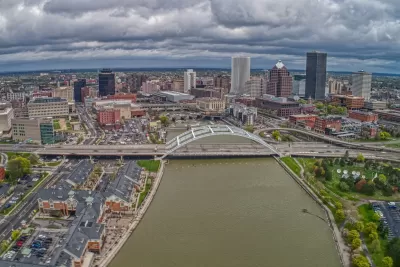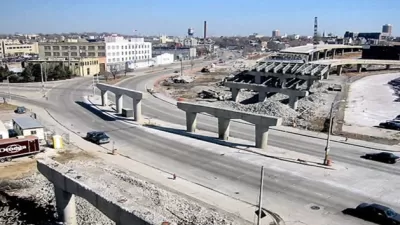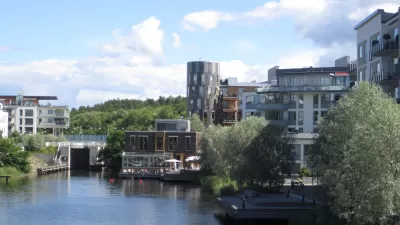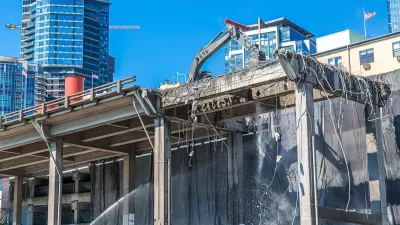A former freeway is undergoing a massive redevelopment that goes beyond highway removal to reconnect and revitalize surrounding areas.

What happens to a former freeway? In Rochester, New York the answer is: a lot. As Mark Byrnes explains in Bloomberg CityLab, “Turn off Union Street — the street-level boulevard that replaced the below-grade Inner Loop — onto the newly established thoroughfare dubbed Adventure Place and you’ll see a hotel and gaming cafe leading to four-story apartment buildings and a strikingly modern museum. It’s all part of a branded development called the Neighborhood of Play, anchored by the Strong National Museum of Play, a 375,000-square-foot interactive attraction that opened in 1982 and recently completed a $75 million expansion.”
Built in the 1960s heyday of massive freeway projects, the Inner Loop declined in usefulness in the following decades and was first closed down in 2014. “Today, the footprint of the highway removal project known as Inner Loop East looks like a checklist of 2010s US urban design priorities: Bulb-outs, protected bike lanes, apartment buildings with varied brick facades, first-floor retail and landscaped sidewalks hug the downtown side of Union Street.”
The project, which is still ongoing, serves as a useful model for other cities seeking to use Reconnecting Communities grants to remove underutilized freeway segments and stitch together neighborhoods divided by highways. Byrnes describes the challenges faced by the projects and the ways that the city worked to understand how to best redevelop the areas where the highway used to be.
FULL STORY: What Happens After a Highway Dies

Study: Maui’s Plan to Convert Vacation Rentals to Long-Term Housing Could Cause Nearly $1 Billion Economic Loss
The plan would reduce visitor accommodation by 25,% resulting in 1,900 jobs lost.

North Texas Transit Leaders Tout Benefits of TOD for Growing Region
At a summit focused on transit-oriented development, policymakers discussed how North Texas’ expanded light rail system can serve as a tool for economic growth.

Why Should We Subsidize Public Transportation?
Many public transit agencies face financial stress due to rising costs, declining fare revenue, and declining subsidies. Transit advocates must provide a strong business case for increasing public transit funding.

How to Make US Trains Faster
Changes to boarding platforms and a switch to electric trains could improve U.S. passenger rail service without the added cost of high-speed rail.

Columbia’s Revitalized ‘Loop’ Is a Hub for Local Entrepreneurs
A focus on small businesses is helping a commercial corridor in Columbia, Missouri thrive.

Invasive Insect Threatens Minnesota’s Ash Forests
The Emerald Ash Borer is a rapidly spreading invasive pest threatening Minnesota’s ash trees, and homeowners are encouraged to plant diverse replacement species, avoid moving ash firewood, and monitor for signs of infestation.
Urban Design for Planners 1: Software Tools
This six-course series explores essential urban design concepts using open source software and equips planners with the tools they need to participate fully in the urban design process.
Planning for Universal Design
Learn the tools for implementing Universal Design in planning regulations.
Ascent Environmental
Borough of Carlisle
Institute for Housing and Urban Development Studies (IHS)
City of Grandview
Harvard GSD Executive Education
Toledo-Lucas County Plan Commissions
Salt Lake City
NYU Wagner Graduate School of Public Service





























